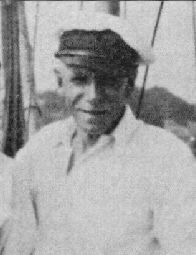Small Craft
Late 19th & Early 20th Century British Yachting
The Sailors: Amateur British & Irish Yachtsmen Before World War One
Charles Pears, 1873–1958

English painter, born in Pontefract, Yorkshire, on 9 September 1873 and educated at East Hardwick and Pomfret College. He tended to specialize in marine scenes and was later appointed the first president of the Society of Naval Artists. He remained a lifelong admirer of Canaletto. Throughout his career he also worked as an illustrator, contributing to The Yellow Book, The Illustrated London News, Punch, The Graphic and other periodicals. As a designer of posters, his images for the London Metropolitan Railway (Southend, 1915) and the Empire Marketing Board (The Empire Highway to India, 1928) reached a wide audience. During the First World War, Pears was appointed an official war artist to the Admiralty in addition to holding a commission in the Royal Marines. He once again worked as a war artist during the Second World War. One such work from this period is his The Jervis Bay Action from 1940 which hangs in the National Maritime Museum, London. It is distinctive for its pinpoint, crystal-clear detail. He lived in London, later moving to Saint Mawes in Cornwall, and was a member of the Royal Institute of Painters in Oil Colours. He died in Truro in January 1958. He is commemorated in a prize at the Royal Society of Marine Artists. annual exhibition: the Charles Pears Memorial Award.
In 1907 Pears described his notion of a single-handed sailor, perhaps with a touch of intransigence, for The Yachting Monthly in an article aptly titled The "Single-Hander". It reads almost like a polemic—daring the reader to admit to any different approach to single-handed sailing. Given Pears' reputation as something of a gruff man's man with no tolerance for anything namby-pamby or improper (to him at least), the article seems right in character. It turned out to be an article referenced by a number of other sailors within that magazine's pages over the next year or two—including a reference by Albert Strange.
One of Pears' articles for The Yachting Monthly—Bringing Home the Mave Rhoe is available on this site. Mave Rhoe would be a boat that Arthur Watts would later own.
Pears purchased his last yacht, Wanderer, from Maurice Griffiths' fledgling brokerage in 1923. Griffiths described Pears:
One of Pears' articles for The Yachting Monthly—Bringing Home the Mave Rhoe is available on this site. Mave Rhoe would be a boat that Arthur Watts would later own.
Pears purchased his last yacht, Wanderer, from Maurice Griffiths' fledgling brokerage in 1923. Griffiths described Pears:
"He was a jolly fine man. A bluff old Yorkshireman. He gave me a good price for that yacht in those days - 𧹡. It was a substantial figure because you could buy a fairly old but reasonable boat for 𧴜 then."
The Magician of the Swatchways
Interestingly, some years later, in 1934, Griffiths and his wife Peter Gerrard (Dulcie Kennard's nom de plume and the name she seems to have been universally known by) seperated in an amicable divorce and she promptly married Pears who had been recently widowed.
Known Boats:
Known Boats:
- Dorothy
- Mave Rhoe—a 4–ton George Flemmich sloop built by the Teignmouth Ship & Yacht Company
- Rose
- Wanderer—a 10–ton Arthur E. Payne yawl built in 1881, presumeably by Summers & Payne